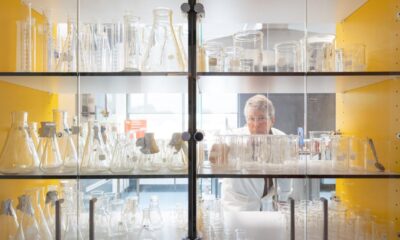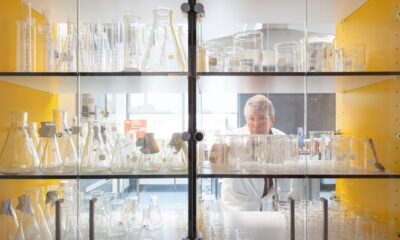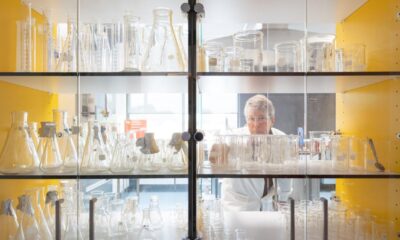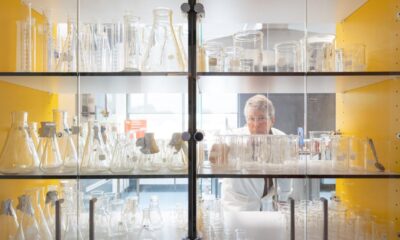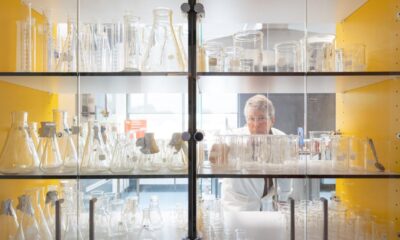Science
Researching Heritage Apples to Preserve Genetic Diversity

A significant research initiative is underway at the Jim Dunckley Heritage Orchard in New Zealand, where master of science student Aaron Hewson is analysing over 300 apple varieties. This orchard, established by the Coastal Otago Branch of the New Zealand Tree Crops Association 25 years ago, is believed to be one of the most diverse collections of apple cultivars in the country. It features unique varieties with intriguing names like Peasgood Nonsuch, Nonnetit Bastard, Warner’s King, and Albany Beauty.
Hewson’s research aims to aid in the preservation and propagation of these heritage cultivars through genetic identification. “I am doing this research for them so they can continue to preserve and propagate the heritage cultivars, with confident identification by genetic means,” he stated. The cultivars were originally collected in the 1990s by Jim Dunckley from various locations across Otago and Southland, with many coming from an old Plant & Food Research orchard in Clyde.
The orchard contains a diverse assortment of apple trees, some named by local farmers after nearby landmarks. However, these names often do not correspond to the actual genetics of the trees. “There is one case where we had a Plant & Food apple called Granny Smith, the classic one you get in supermarkets, and another one called Lord Lambourne. These two cultivars should be really different, but the samples were saying they were genetically the same,” Hewson explained.
To investigate these discrepancies, samples were collected by university students and staff from the Plant Biochemistry Lab. These samples were then freeze-dried, labelled, and sent to a laboratory in France for genetic analysis, supported by the Plant & Food Research, which is now part of the Bioeconomy Science Institute. Hewson acknowledged the assistance of his co-supervisor, Dr. Elena Lopez-Girona, from Plant & Food Research, highlighting her expertise as invaluable during this process.
“They allowed us to send our samples with their bulk group of samples for genotyping by SNP chip,” Hewson noted. The SNP chip is a laboratory technique that examines approximately 50,000 known DNA hotspots in an apple leaf, creating a genetic fingerprint to determine whether two trees belong to the same variety.
The preservation of these heritage apples is crucial, particularly given the stringent biosecurity regulations that complicate the importation of new apple genetics into New Zealand. Hewson pointed out the alarming statistics regarding global apple diversity: “If we talk about the entire amount of apples across the world, there is something on the order of 10,000 different varieties. But all of our commercial varieties, no matter how many there are, they all come from six apples, so it is really, really narrow.”
Associate Professor Lynnette Brownfield from the University of Otago, who is also a co-supervisor for Hewson’s research, emphasized the potential benefits of identifying the genetic makeup of the orchard’s apples. Since commercial apples in New Zealand derive from a limited genetic pool, uncovering the genetic diversity in the orchard could provide breeders with new options, including disease resistance.
The Coastal Otago Branch of the New Zealand Tree Crops Association will ultimately determine how to use the findings from this research. The goal is to assign identification to all trees within the orchard, facilitating communication with apple breeders ranging from backyard growers to established organizations like Plant & Food Research. This effort will also enable the provision of germplasm as needed, further supporting the preservation of apple diversity in the region.
By delving into the genetic diversity of these heritage varieties, the research not only seeks to safeguard New Zealand’s apple heritage but also to contribute to broader efforts in enhancing apple breeding for future generations.
-
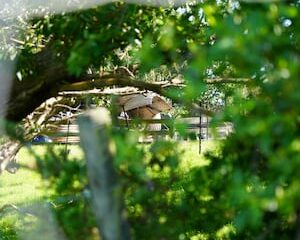
 World1 week ago
World1 week agoPrivate Funeral Held for Dean Field and His Three Children
-

 Top Stories2 weeks ago
Top Stories2 weeks agoFuneral Planned for Field Siblings After Tragic House Fire
-

 Sports3 months ago
Sports3 months agoNetball New Zealand Stands Down Dame Noeline Taurua for Series
-

 Entertainment3 months ago
Entertainment3 months agoTributes Pour In for Lachlan Rofe, Reality Star, Dead at 47
-

 Entertainment2 months ago
Entertainment2 months agoNew ‘Maverick’ Chaser Joins Beat the Chasers Season Finale
-

 Sports3 months ago
Sports3 months agoSilver Ferns Legend Laura Langman Criticizes Team’s Attitude
-

 Sports1 month ago
Sports1 month agoEli Katoa Rushed to Hospital After Sideline Incident During Match
-

 World2 weeks ago
World2 weeks agoInvestigation Underway in Tragic Sanson House Fire Involving Family
-

 Politics2 months ago
Politics2 months agoNetball NZ Calls for Respect Amid Dame Taurua’s Standoff
-

 Top Stories2 weeks ago
Top Stories2 weeks agoShock and Grief Follow Tragic Family Deaths in New Zealand
-

 Entertainment3 months ago
Entertainment3 months agoKhloe Kardashian Embraces Innovative Stem Cell Therapy in Mexico
-

 World4 months ago
World4 months agoPolice Arrest Multiple Individuals During Funeral for Zain Taikato-Fox



